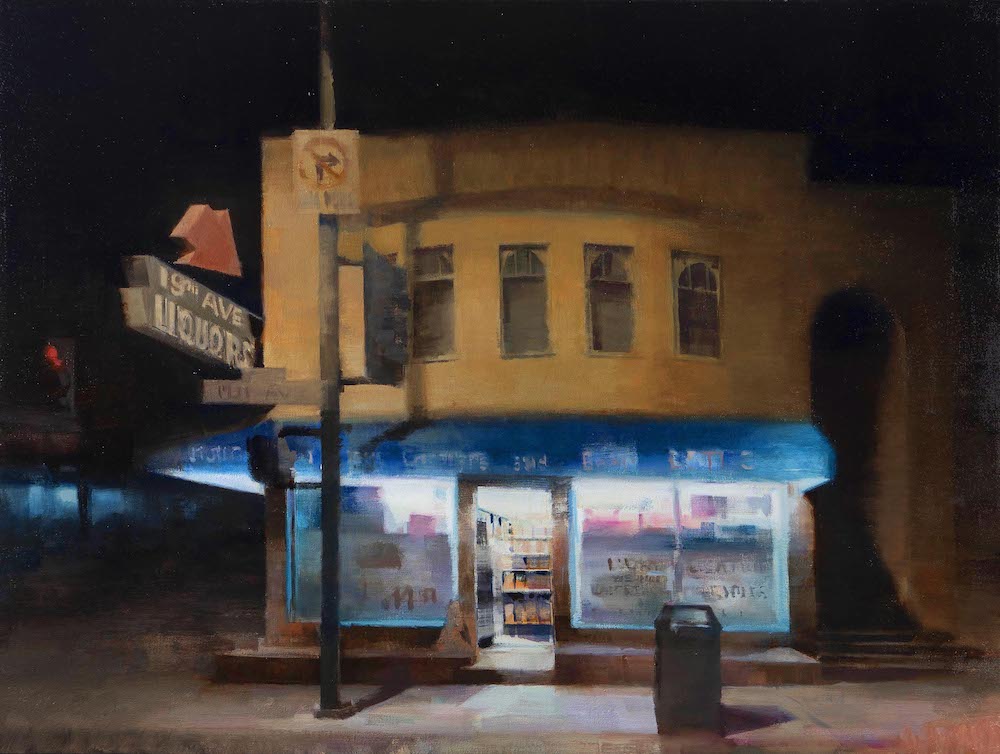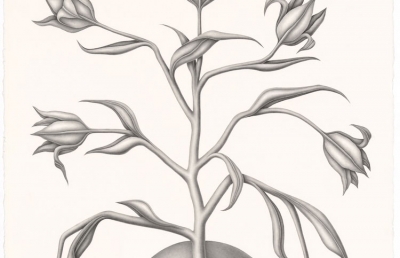If you grew up in, or spent years in San Francisco, you know there is a special aura of the place that goes beyond the tech world or Golden Gates. There is a grittiness and special sort sense of being lost in the avenues that if you know you know. Kim Cogan captures that majestic darkness in his new body of work, Here Nor There, and on the occasion of his solo show at Hashimoto Contemporary in SF, the gallery's Vanessa Indies stopped in to speak with the artist.
Vanessa Indies: Here Nor There is the title of your new exhibition of works, could you explain why you chose that title and what one can reflect on while viewing these pieces in person?
Kim Cogan: The idea of place is an important part of my work, but for this show, I approached that idea differently because of the pandemic and being sheltered-in-place. I thought a lot about places that were familiar to me, but weren’t physically at reach. So the title is pretty literal in that way. My work is also influenced a lot by memories, and I tried to convey that tension between past and present.
When I sit with your paintings and take them in, I realize how much mood there is in each piece. These moods seem to drastically change depending on the time of day/location. Are these something that you intentionally incorporate at the beginning of painting, or do they evolve throughout your painting process?
Yes, I try to put a lot of emphasis on expressiveness. The tone of the painting, lighting, color palette, the paint texture itself—they all come together to express a particular mood.
Could you explain your relationship with the Sunset and Richmond districts? How did your view of those neighborhoods change during COVID while being in lockdown?
I’ve lived on the west side of the city for many years. It’s true what they say, you paint what you know best, so it’s very natural for me to draw inspiration from what’s around me. There’s an honesty in this approach, and I think my paintings wouldn’t be what they are without that familiarity and intimacy. I found myself thinking a lot about these businesses in the neighborhood, wondering if they would survive, and that motivated me to capture them in my work.
This series of works seems very dreamlike, how has the affects of lockdown and the city's impending fate worked its way into your painting process? Were there any specific moments during the lockdown that you wanted to make sure you captured in your new body of work? For example, the feeling of loneliness or abandonment in an empty street, or the stress in the unknowing of the city, small businesses and families futures.
It’s funny because even before the pandemic, I tended to paint empty streets without any people because I wanted to communicate a certain mood. Then during the lockdown, I would walk around and was struck by how eerily empty and quiet even normally busy streets were. I took a lot of photos during this time and just tried to capture that sense of isolation.
I love the nod to old San Francisco restaurants & establishments in your current body of work, especially the giant dog head from the original ‘Doggie Diner’ and the ‘Cliff House’ - What are some of your favorite SF establishments that inspire and spark nostalgia for you?
There are too many to name, and so many I have yet to visit. That’s part of the beauty of living in a city that offers so much inspiration. Even places that are familiar to me I can revisit and experience in a different way. What catches my eye is often hidden in plain sight. SF has so much history and it would be such a shame for these old establishments to completely disappear.
Do you tend to visit and sit within locations that you’re about to paint? Or do you leave most of the concept up to past visual references and memories of a certain area?
I’ll go back to a place as much as possible to take in all the sights, sounds, and surroundings. Often I'll ask myself, what if the lighting was soft from the fog, or how would this look at night?
You’ve spoken about this series of work as having more of a longing feeling of nostalgic sceneries rather than the discovery of new places - could you expand on that more?
Discovery and personal experience are always a part of my work, but for this show, I found myself thinking more about the places that were familiar to me. I had this fear that everything I knew of the city could disappear. So I tried to be more deliberate about the subject matter this time around.
I really loved that you used a quote by geographer Yi-Fu Tuan to explain your work: “Here is a seeming paradox: thought creates distance and destroys the immediacy of direct experience, yet it is by thoughtful reflection that the elusive moments of the past draw near to us in present reality and gain a measure of permanence.” - could you elaborate more on how you’ve used reflection in your own practice to create a sense of permanence within the sceneries of your pieces?
I think a lot of people felt a sense of isolation during the pandemic. For me, it created a distance that allowed me to reflect on places that had special meaning. And in a way, the distance made my attachment to those places even stronger.
Here Nor There will be on view at Hashimoto Contemporary in SF through October 23rd. Studio shots & gallery layout photos by Shaun Roberts




























